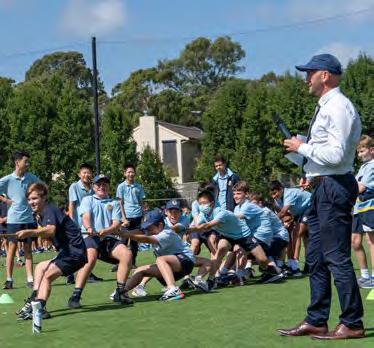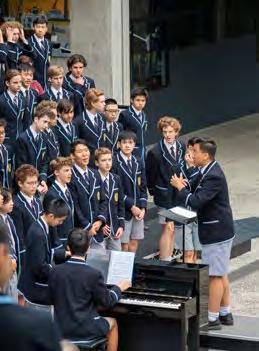
8 minute read
History of the Houses
Who were the individuals behind the House names and what was their connection to the School? School Historian and Archivist, Dr David Bird, shares some insight into the origins and men behind the Houses.
Today, there are eight Houses and, in the Senior School, each House is made up, on average, of 85 boys from Years 9-12. Tutors and respective Heads of House are responsible for the ongoing pastoral care of each student within the House. Outside the classroom, the life of the School community is very largely exercised through this House System. Not only do Houses organise sporting, cultural and charitable activities, such as the much-loved House Music Competition and ubercompetitive House Athletics, but they attempt to achieve the basic ideals of the School, which is the close co-operation between all its members and the care for each individual in their total education.
Headmaster Alfred Hall, ‘the Old boss’, presided over the introduction of a House system in 1924, with the original four Houses, Cresswell, Macrow, Maxwell, and browne, and Camberwell Grammar’s pastoral care system has been based around the operation of the House and Tutor system ever since.
To the regret of the retired Alfred Hall, the Council of the newly-sited School saw fit in 1935 to rename three of the Houses, replacing Hall’s original titles with those of two Council members and one other associated family (Macneil, Robinson and Summons) who were key members in the transition of the School between 1926-27.
Derham (established in 1924)
Derham began its journey as Creswell House. From 1873-1912, Reverend Arthur William Cresswell was the Anglican minister of St John’s, Camberwell (where the School was sited in 1886. Cresswell also taught Scripture, Chemistry and ‘Physiology’ at the School. He had been instrumental in the establishment of Arthur Taylor’s school at his church in 1886 and his three sons were foundation Alumni.
However, after the introduction of the Houses, some Alumni pressure led to Derham replacing the name of the late Reverend Cresswell after only a single term. The House was then named after the late Major-General Francis Derham (1901), who attended Camberwell Grammar in its earliest years, and was one of the founders of the OCGA in 1910. He was the most outstanding Grammarian veteran of the Great War, serving at Gallipoli and on the western front. Mr Hall’s personal solicitor and close friend following the war, he served on the Council from 1926-1951. He was a prominent industrial lawyer in Melbourne and frequently addressed boys on Speech Night and on cadet occasions.
In 1910, and in cooperation with others, Derham also helped to establish Camberwell Grammar as a Church of England Public School and was connected with the school for over 60 years.


Macneil (established 1924)
Macneil was originally established as Macrow House, which stuck until 1935. William Macrow was a past student (1903) serving in the cadets and he received the Old Grammarians Cup for Sport in 1907. A Victorian Sheffield Shield cricketer before the war, he enlisted in the AIF, serving as a Lieutenant in the AIF in belgium and France, 1916-18, where he was awarded the Military Cross for ‘conspicuous gallantry and devotion to duty’.

In 1935, the name was changed to Macneil, a tribute to the family who were the owners of Roystead, the original property on which Camberwell Grammar now stands. The property was purchased at auction in 1934 for £12,500 and the Macneil family assisted with a gift of £750.

Robinson (established 1924)
Known as Maxwell House prior to 1935, George Maxwell MHR was a patron of the School and a prominent Melbourne lawyer. He had also taught at Melbourne private schools. He chaired Camberwell Grammar Speech Nights for over twenty-five years, frequently addressing the boys, and was a close friend of Alfred Hall.
In 1935, the name was changed to Robinson House after Mr J.G. Robinson, who was the first Secretary of the School Council from 1927 and remained a member of the Council as a representative of St. Mark’s Vestry until his death in 1962. Mr J.G. Robinson was actively associated with Camberwell Grammar School for over 40 years. He was instrumental in the acquisition of the Mont Albert Road property and in the appointment of subsequent Headmasters.

Summons (established 1924)
Before 1935, Summons was originally browne House. The solicitor Walter browne was a member of a prominent Camberwell family. browne donated many prizes to the School and there were important links between the browne and Hall families stretching back decades – Grammarians were even allowed access to the tennis courts of the family’s Camberwell estate, ‘The Hollies’. browne was also the godfather of Alfred Hall’s only son Ingle and assisted his close friend in the acquisition of new sites further up burke Road in the direction of Canterbury on burke Hill as the School bid farewell to the Junction in 1908.
Post name-change, the House became Summons after the late Dr Walter Summons, a long-standing member of the Council and the personal physician of William Angliss. He was instrumental in lobbying Angliss on many occasions to extend loans to the School, including at the time of the acquisition of Roystead.
Bridgland (established 1972)
Bridgland House was chosen in recognition of Mr Lionel bridgland, a Councillor for almost thirty years, mostly on the Finance and Executive committees. He was inducted as a Life Governor in 1960 and was associated with the Outward bound Movement and instrumental in the acquisition of the bambara property, 1962-63, intended to operate as a school bush camp. He was also closely associated with the School raising sufficient finance for much of its post-war expansion.

Schofield (established 1972)
Schofield commemorates the name of Archdeacon James Schofield, who, as Vicar of St. Mark’s, became ex officio Chairman of the School Council when the School was incorporated as a non-profit making company limited by guarantee. It may be said that the existence of the modern-day Camberwell Grammar School is largely due to Archdeacon Schofield’s energy and initiative.
An Oxford graduate, he was formerly a Professor of Sanskrit and English at a college associated with the University of Madras, India. His wife, a Victorian, found the Indian climate stressful, so the couple moved to Melbourne during the war, intending to return to England after the end of hostilities. However, they stayed on, Schofield soon lecturing in Theology at the University of Melbourne and becoming the vicar at St. Mark’s in 1921.
Having presided over the foundation of Camberwell Girls’ Grammar in 1920, he was instrumental in the transition of Camberwell Grammar to a church school in 1926. He was the first chairman of the Council but declined the offer of the inaugural headship of ‘Camberwell Church of England Grammar School’. Schofield, now an Archdeacon, resigned from the Council in December 1938 and left the parish of St. Mark’s for the vicarage of All Saints’, East St Kilda. As the vicar of St Mark’s he had been the inaugural Chaplain of Camberwell Grammar, playing a seminal part in the development and administration of the School, often behind the scenes.

Clifford (established 1986)
Mr Bruce Clifford, a past Grammarian and Life Governor of the school, attended Camberwell Grammar School from 1927 to 1937, and has had three sons also pass through the School. He joined the School Council in 1964, and became Treasurer in 1968, a position he held until 1985. A Commerce graduate from the University of Melbourne, he was for many years Company Secretary of Associated Pulp and Paper Mills Ltd. During his seventeen years as Treasurer, Mr Clifford was actively involved in the School’s continuing expansion, particularly in the purchase of the adjoining properties of Kingussie, Walsh Street and Norge. It is a tribute to his calm direction that one of the two new Houses was named after him.
Steven (established 1986)
Mr John Steven has also had three sons through the School. A Civil Engineer and Town Planning Consultant, Mr Steven first became a member of the School Council as a representative of the Parents’ Association in 1974, was a member of the Executive Finance Committee, and served as Deputy Chairman from 1987 to 1994. He played a major role in the creation of the Shenley Ground and the development of the Junior School on the Norge site. Steven House will be a constant reminder of his services to the School.










